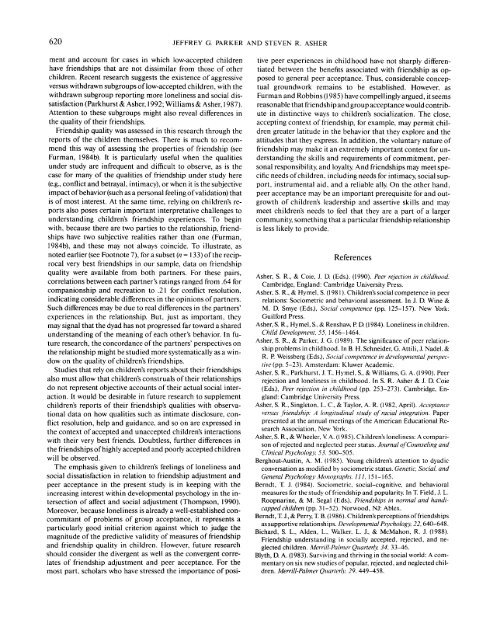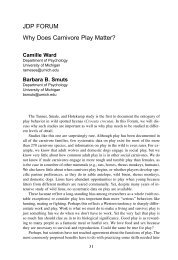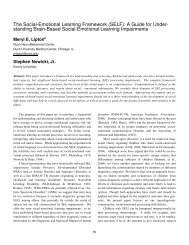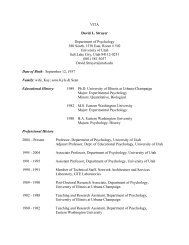Friendship and Friendship Quality in Middle Childhood ... - Psychology
Friendship and Friendship Quality in Middle Childhood ... - Psychology
Friendship and Friendship Quality in Middle Childhood ... - Psychology
You also want an ePaper? Increase the reach of your titles
YUMPU automatically turns print PDFs into web optimized ePapers that Google loves.
620 JEFFREY G. PARKER AND STEVEN R. ASHER<br />
merit <strong>and</strong> account for cases <strong>in</strong> which low-accepted children<br />
have friendships that are not dissimilar from those of other<br />
children. Recent research suggests the existence of aggressive<br />
versus withdrawn subgroups of low-accepted children, with the<br />
withdrawn subgroup report<strong>in</strong>g more lonel<strong>in</strong>ess <strong>and</strong> social dissatisfaction<br />
(Parkhurst&Asher, 1992; Williams &Asher, 1987).<br />
Attention to these subgroups might also reveal differences <strong>in</strong><br />
the quality of their friendships.<br />
<strong>Friendship</strong> quality was assessed <strong>in</strong> this research through the<br />
reports of the children themselves. There is much to recommend<br />
this way of assess<strong>in</strong>g the properties of friendship (see<br />
Furman, 1984b). It is particularly useful when the qualities<br />
under study are <strong>in</strong>frequent <strong>and</strong> difficult to observe, as is the<br />
case for many of the qualities of friendship under study here<br />
(e.g., conflict <strong>and</strong> betrayal, <strong>in</strong>timacy), or when it is the subjective<br />
impact of behavior (such as a personal feel<strong>in</strong>g of validation) that<br />
is of most <strong>in</strong>terest. At the same time, rely<strong>in</strong>g on children's reports<br />
also poses certa<strong>in</strong> important <strong>in</strong>terpretative challenges to<br />
underst<strong>and</strong><strong>in</strong>g children's friendship experiences. To beg<strong>in</strong><br />
with, because there are two parties to the relationship, friendships<br />
have two subjective realities rather than one (Furman,<br />
1984b), <strong>and</strong> these may not always co<strong>in</strong>cide. To illustrate, as<br />
noted earlier (see Footnote 7), for a subset (n = 133) of the reciprocal<br />
very best friendships <strong>in</strong> our sample, data on friendship<br />
quality were available from both partners. For these pairs,<br />
correlations between each partner's rat<strong>in</strong>gs ranged from .64 for<br />
companionship <strong>and</strong> recreation to .21 for conflict resolution,<br />
<strong>in</strong>dicat<strong>in</strong>g considerable differences <strong>in</strong> the op<strong>in</strong>ions of partners.<br />
Such differences may be due to real differences <strong>in</strong> the partners'<br />
experiences <strong>in</strong> the relationship. But, just as important, they<br />
may signal that the dyad has not progressed far toward a shared<br />
underst<strong>and</strong><strong>in</strong>g of the mean<strong>in</strong>g of each other's behavior. In future<br />
research, the concordance of the partners' perspectives on<br />
the relationship might be studied more systematically as a w<strong>in</strong>dow<br />
on the quality of children's friendships.<br />
Studies that rely on children's reports about their friendships<br />
also must allow that children's construals of their relationships<br />
do not represent objective accounts of their actual social <strong>in</strong>teraction.<br />
It would be desirable <strong>in</strong> future research to supplement<br />
children's reports of their friendship's qualities with observational<br />
data on how qualities such as <strong>in</strong>timate disclosure, conflict<br />
resolution, help <strong>and</strong> guidance, <strong>and</strong> so on are expressed <strong>in</strong><br />
the context of accepted <strong>and</strong> unaccepted children's <strong>in</strong>teractions<br />
with their very best friends. Doubtless, further differences <strong>in</strong><br />
the friendships of highly accepted <strong>and</strong> poorly accepted children<br />
will be observed.<br />
The emphasis given to children's feel<strong>in</strong>gs of lonel<strong>in</strong>ess <strong>and</strong><br />
social dissatisfaction <strong>in</strong> relation to friendship adjustment <strong>and</strong><br />
peer acceptance <strong>in</strong> the present study is <strong>in</strong> keep<strong>in</strong>g with the<br />
<strong>in</strong>creas<strong>in</strong>g <strong>in</strong>terest with<strong>in</strong> developmental psychology <strong>in</strong> the <strong>in</strong>tersection<br />
of affect <strong>and</strong> social adjustment (Thompson, 1990).<br />
Moreover, because lonel<strong>in</strong>ess is already a well-established concommitant<br />
of problems of group acceptance, it represents a<br />
particularly good <strong>in</strong>itial criterion aga<strong>in</strong>st which to judge the<br />
magnitude of the predictive validity of measures of friendship<br />
<strong>and</strong> friendship quality <strong>in</strong> children. However, future research<br />
should consider the divergent as well as the convergent correlates<br />
of friendship adjustment <strong>and</strong> peer acceptance. For the<br />
most part, scholars who have stressed the importance of posi-<br />
tive peer experiences <strong>in</strong> childhood have not sharply differentiated<br />
between the benefits associated with friendship as opposed<br />
to general peer acceptance. Thus, considerable conceptual<br />
groundwork rema<strong>in</strong>s to be established. However, as<br />
Furman <strong>and</strong> Robb<strong>in</strong>s (1985) have compell<strong>in</strong>gly argued, it seems<br />
reasonable that friendship <strong>and</strong> group acceptance would contribute<br />
<strong>in</strong> dist<strong>in</strong>ctive ways to children's socialization. The close,<br />
accept<strong>in</strong>g context of friendship, for example, may permit children<br />
greater latitude <strong>in</strong> the behavior that they explore <strong>and</strong> the<br />
attitudes that they express. In addition, the voluntary nature of<br />
friendship may make it an extremely important context for underst<strong>and</strong><strong>in</strong>g<br />
the skills <strong>and</strong> requirements of commitment, personal<br />
responsibility, <strong>and</strong> loyalty. And friendships may meet specific<br />
needs of children, <strong>in</strong>clud<strong>in</strong>g needs for <strong>in</strong>timacy, social support,<br />
<strong>in</strong>strumental aid, <strong>and</strong> a reliable ally. On the other h<strong>and</strong>,<br />
peer acceptance may be an important prerequisite for <strong>and</strong> outgrowth<br />
of children's leadership <strong>and</strong> assertive skills <strong>and</strong> may<br />
meet children's needs to feel that they are a part of a larger<br />
community, someth<strong>in</strong>g that a particular friendship relationship<br />
is less likely to provide.<br />
References<br />
Asher, S. R., & Coie, J. D. (Eds.). (1990). Peer rejection <strong>in</strong> childhood.<br />
Cambridge, Engl<strong>and</strong>: Cambridge University Press.<br />
Asher, S. R., & Hymel, S. (1981). Children's social competence <strong>in</strong> peer<br />
relations: Sociometric <strong>and</strong> behavioral assessment. In J. D. W<strong>in</strong>e &<br />
M. D. Smye (Eds.), Social competence (pp. 125-157). New York:<br />
Guilford Press.<br />
Asher, S. R., Hymel, S., & Renshaw, R D. (1984). Lonel<strong>in</strong>ess <strong>in</strong> children.<br />
Child Development, 55,1456-1464.<br />
Asher, S. R., & Parker, J. G. (1989). The significance of peer relationship<br />
problems <strong>in</strong> childhood. In B. H.Schneider.G. Attili, J. Nadel,&<br />
R. P. Weissberg (Eds.), Social competence <strong>in</strong> developmental perspective<br />
(pp. 5-23). Amsterdam: Kluwer Academic.<br />
Asher, S. R., Parkhurst. J. T, Hymel, S., & Williams, G. A. (1990). Peer<br />
rejection <strong>and</strong> lonel<strong>in</strong>ess <strong>in</strong> childhood. In S. R. Asher & J. D. Coie<br />
(Eds.), Peer rejection <strong>in</strong> childhood (pp. 253-273). Cambridge, Engl<strong>and</strong>:<br />
Cambridge University Press.<br />
Asher, S. R., S<strong>in</strong>gleton, L. C, & Taylor, A. R. (1982, April). Acceptance<br />
versus friendship: A longitud<strong>in</strong>al study of racial <strong>in</strong>tegration. Paper<br />
presented at the annual meet<strong>in</strong>gs of the American Educational Research<br />
Association, New York.<br />
Asher, S. R., & Wheeler, V A. (1985). Children's lonel<strong>in</strong>ess: A comparison<br />
of rejected <strong>and</strong> neglected peer status. Journal of Counsel<strong>in</strong>g <strong>and</strong><br />
Cl<strong>in</strong>ical <strong>Psychology</strong>, 53. 500-505.<br />
Berghout-Aust<strong>in</strong>, A. M. (1985). Young children's attention to dyadic<br />
conversation as modified by sociometric status. Genetic, Social, <strong>and</strong><br />
General <strong>Psychology</strong> Monographs, 111, 151-165.<br />
Berndt, T. J. (1984). Sociometric, social-cognitive, <strong>and</strong> behavioral<br />
measures for the study of friendship <strong>and</strong> popularity. In T. Field, J. L.<br />
Roopnar<strong>in</strong>e, & M. Segal (Eds.), <strong>Friendship</strong>s <strong>in</strong> normal <strong>and</strong> h<strong>and</strong>icapped<br />
children (pp. 31-52). Norwood, NJ: Ablex.<br />
Berndt, T. J., & Perry, T. B. (1986). Children's perceptions of friendships<br />
as supportive relationships. Developmental <strong>Psychology</strong>, 22, 640-648.<br />
Bichard, S. L., Alden, L., Walker, L. J., & McMahon, R. J. (1988).<br />
<strong>Friendship</strong> underst<strong>and</strong><strong>in</strong>g <strong>in</strong> socially accepted, rejected, <strong>and</strong> neglected<br />
children. Merrill-Palmer Quarterly, 34, 33-46.<br />
Blyth, D. A. (1983). Surviv<strong>in</strong>g <strong>and</strong> thriv<strong>in</strong>g <strong>in</strong> the social world: A commentary<br />
on six new studies of popular, rejected, <strong>and</strong> neglected children.<br />
Merrill-Palmer Quarterly, 29, 449-458.





